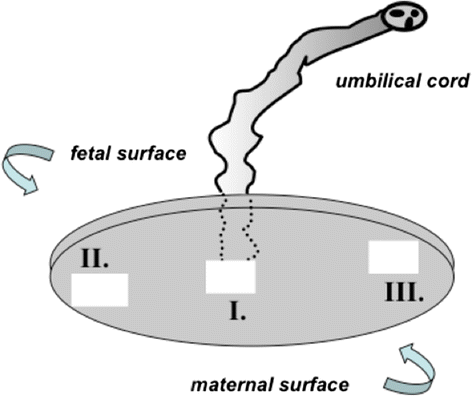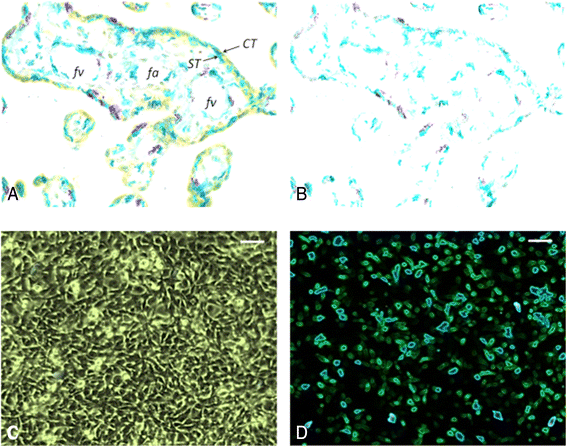Myometrial contractility influences oxytocin receptor (OXTR) expression in term trophoblast cells obtained from the maternal surface of the human placenta
- PMID: 26377392
- PMCID: PMC4573466
- DOI: 10.1186/s12884-015-0656-3
Myometrial contractility influences oxytocin receptor (OXTR) expression in term trophoblast cells obtained from the maternal surface of the human placenta
Abstract
Background: Oxytocin (OXT) acts through its specific receptor (OXTR) and increased density of OXTR and/or augmented sensitivity to OXT were postulated as prerequisites of normal onset of labor. Expression of OXTR in the placental term trophoblast cells has not yet been analyzed in the context of contractile activity of the uterus. Here we examine comparatively OXT contents in the placental tissue adjacent to the uterine wall and expressions of OXTR in this tissue and corresponding isolated placental trophoblast cells.
Methods: Twenty eight placentae after normal labors at term (group I, N = 14) and after cesarean sections performed without uterine contractile activity (group II, N = 14) have been collected. Tissue excised from the maternal surface of examined placenta was used for OXT concentration measurement, cytotrophoblast cell cultures preparation and immunohistochemistry of OXTR. Concentration of OXT was estimated in the tissue homogenates by an enzyme immunoassay with colorimetric detection. Cytotrophoblast cells were isolated using Kliman's method based on trypsin, DNase, and a 5-70% Percoll gradient centrifugation. The cultures were incubated for 5 days in normoxia. Both placental specimens and terminated cytotrophoblast cultures were fixed and embedded in paraffin before being immunostained for OXTR. Using light microscopy with computed morphometry for quantitative analysis, OXTR expressions were estimated in calibrated areas of the paraffin sections.
Results: There were not significant differences between the groups in respect to the mean OXT concentration. However, in both groups the median value of OXT concentration was significantly (p < 0.05) higher in the tissue obtained from the peripheral regions of the maternal surface of the placenta, compared to the samples from the central region of this surface. In placental tissue the mean expression of OXTR in group I was significantly (p < 0.05) increased by approximately 3.2-fold and 3.45-fold (the samples collected from central and peripheral regions, respectively) compared to the values obtained in group II. In the isolated primary trophoblast cultures the differences were even more evident (p < 0.02) and the mean change in OXTR expression in group I comprised approximately 6.9-fold increase and 6.5-fold increase (the samples collected from central and peripheral regions, respectively) compared to the values obtained in group II.
Conclusions: Upregulation of OXTR within placental trophoblast cells localized close or adherent to uterine wall may play a crucial role in labor with efficient contractile activity (vaginal delivery). Further studies may disclose if this local OXT/OXTR signaling is utilized in the third stage of labor to elicit placental detachment or contribute in a more versatile way throughout the labor period.
Figures




Similar articles
-
The regulation of oxytocin and oxytocin receptor in human placenta according to gestational age.J Mol Endocrinol. 2017 Oct;59(3):235-243. doi: 10.1530/JME-16-0223. Epub 2017 Jul 10. J Mol Endocrinol. 2017. PMID: 28694300
-
Influence of oxytocin receptor single nucleotide sequence variants on contractility of human myometrium: an in vitro functional study.BMC Med Genet. 2019 Nov 12;20(1):178. doi: 10.1186/s12881-019-0894-8. BMC Med Genet. 2019. PMID: 31718582 Free PMC article.
-
Functional Hierarchy of Uterotonics Required for Successful Parturition in Mice.Endocrinology. 2019 Dec 1;160(12):2800-2810. doi: 10.1210/en.2019-00499. Endocrinology. 2019. PMID: 31517984 Free PMC article.
-
The Oxytocin Receptor: From Intracellular Signaling to Behavior.Physiol Rev. 2018 Jul 1;98(3):1805-1908. doi: 10.1152/physrev.00031.2017. Physiol Rev. 2018. PMID: 29897293 Review.
-
Myometrial oxytocin receptor expression and intracellular pathways.Minerva Ginecol. 2014 Jun;66(3):267-80. Minerva Ginecol. 2014. PMID: 24971782 Review.
Cited by
-
DNA methylation landscape in pregnancy-induced hypertension: progress and challenges.Reprod Biol Endocrinol. 2024 Jul 8;22(1):77. doi: 10.1186/s12958-024-01248-0. Reprod Biol Endocrinol. 2024. PMID: 38978060 Free PMC article. Review.
-
Oxytocin receptor DNA methylation is associated with exogenous oxytocin needs during parturition and postpartum hemorrhage.Commun Med (Lond). 2023 Jan 27;3(1):11. doi: 10.1038/s43856-023-00244-6. Commun Med (Lond). 2023. PMID: 36707542 Free PMC article.
-
Relationships Between H2S and OT/OTR Systems in Preeclampsia.Antioxidants (Basel). 2025 Jul 18;14(7):880. doi: 10.3390/antiox14070880. Antioxidants (Basel). 2025. PMID: 40722984 Free PMC article.
-
Re-embarking in ART while still breastfeeding: an unresolved question.Arch Gynecol Obstet. 2025 Feb;311(2):555-565. doi: 10.1007/s00404-025-07933-8. Epub 2025 Jan 20. Arch Gynecol Obstet. 2025. PMID: 39828777 Free PMC article. Review.
-
Haemodynamic stability following adrenaline intracervical block for major haemorrhage during surgical management of late miscarriage: A case report.Case Rep Womens Health. 2022 Dec 17;37:e00476. doi: 10.1016/j.crwh.2022.e00476. eCollection 2023 Mar. Case Rep Womens Health. 2022. PMID: 36593895 Free PMC article.
References
MeSH terms
Substances
LinkOut - more resources
Full Text Sources
Other Literature Sources
Medical

